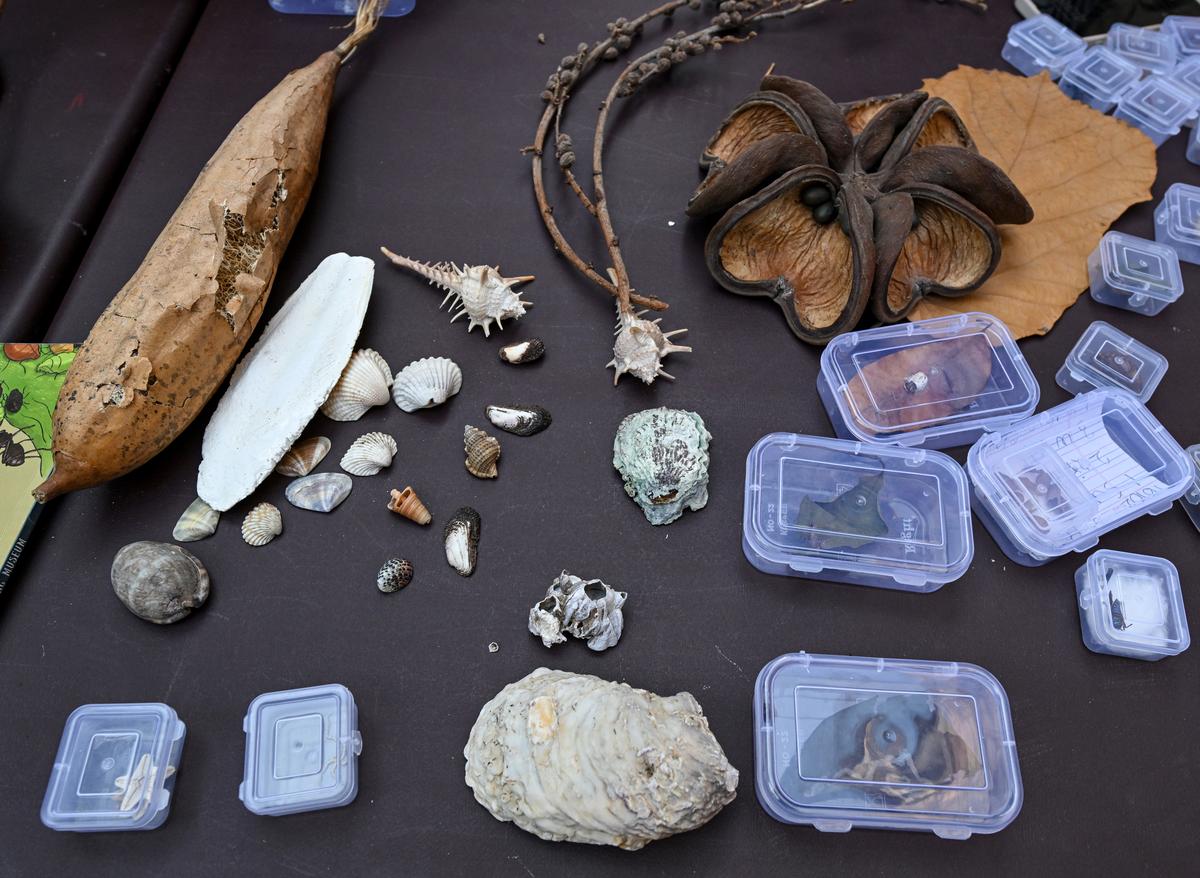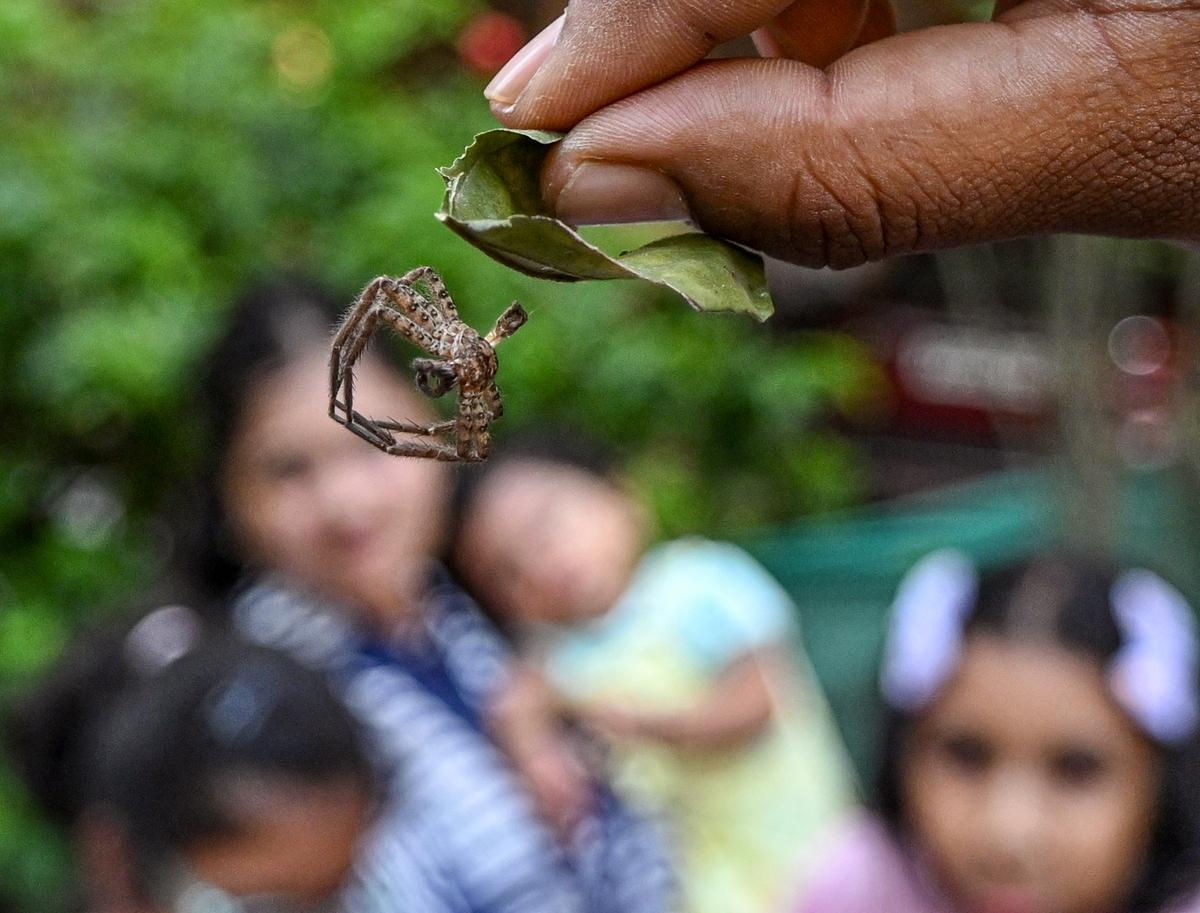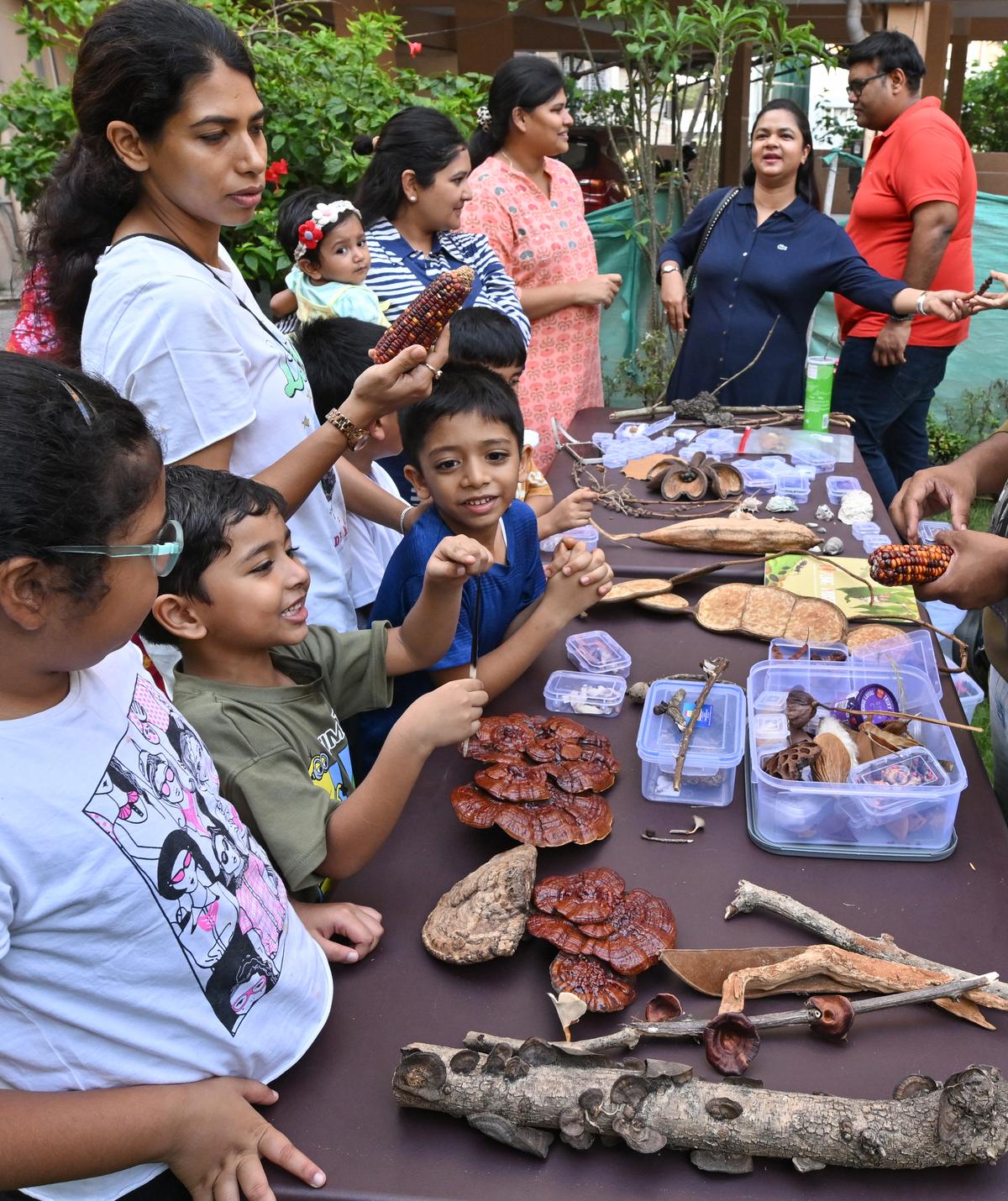Participants experiencing the portable natural history museum by Wilded, a Nature education group, at a residential society in Visakhapatnam.
| Photo Credit: K R DEEPAK
At the edge of a garden in Visakhapatnam, a carpenter bee once drilled a perfect circular hole into an old log of wood. This tiny act of wild engineering caught the attention of naturalist and educator K Vimal Raj. Today, that very log, complete with the bee’s handiwork, is an exhibit at the Natural History Museum by Wilded, a nature education group he founded. It sits on display not behind glass, but where it can be touched, turned, and observed, a tactile reminder of how Nature’s stories are all about the little details.
A few feet away, a large, umbrella-shaped mushroom (Ganoderma species) found at the King George Hospital in the city takes its place beside a table full of seeds – long, oval, spiked, winged – each one a potential lesson in plant life, adaptation, and survival. Bird nests with delicate weaving, starfish specimens, spider molts, and rocks of various textures and colours complete the visual and tactile landscape of this unique museum.
But unlike traditional museums rooted in brick and mortar, Wilded’s Natural History Museum is a place-based portable experience. It can be set up in living rooms, apartment community halls, classrooms, and gardens, wherever curious minds gather. At a recent session hosted in the open space of a residential society in Visakhapatnam, children and adults stood wide-eyed, leaning in as Vimal explained the story of each specimen: the lifecycle of a spider, the importance of decomposers, the shape of seeds and how they travel, and the hidden science in a feather.

Specimens on display at the portable natural history museum session by Wilded, a Nature education group, at a residential society in Visakhapatnam.
| Photo Credit:
K R DEEPAK
“This isn’t just about looking at Nature,” says Vimal Raj. “It’s about noticing the everyday lives of creatures around us and understanding that everything is interconnected.” The museum, he says, is built on that sense of wonder. “We want participants to become familiar with lives that share their spaces, to observe a nest, a spider web, a fallen leaf and ask questions.”
Curated in collaboration with environment groups like Wildlife Conservation Through Research and Education, East Coast Conservation Team, and independent science researchers in the city, the museum includes contributions from all walks of life. The initiative is supported by Youth Conservation Action Network (YouCAN), a non-profit that aims to place an Earth educator in every school and learning space in India. While the pilot project has taken root in Visakhapatnam, the organisers plan to take the portable museum to other cities eventually.
The relatively young museum has exhibits that date back millennia, especially the rocks collected from different geological pockets of the region. “For a keen observer,” Vimal says, “Nature speaks through tracks and signs. That’s how this museum was born. From fallen feathers, rattling gulmohar seed pods, skin sheds of snakes and spiders, and the dozens of little things we often overlook. Each object tells a story. Together, they can spark scientific curiosity, discussions, and even myths and folktales. Everything that helps children and adults reconnect with their immediate natural surroundings.”

A wolf spider molt at the portable natural history museum by Wilded, a Nature education group, in Visakhapatnam.
| Photo Credit:
K R DEEPAK
The museum’s sessions are interactive and the sessions are about an hour long. Children are invited to gently handle the specimens under supervision, examine them under magnifying glasses, ask questions, sketch their observations, or simply sit and wonder. The exhibits go beyond natural artefacts; they also include terrariums, samples from local food systems, and curated displays on sustainability and climate change.
Rachita Gupta, who attended a recent session with her two sons, says it was a magical experience. “The interactive display of preserved insects and plants sparked so much curiosity, respect and appreciation for Nature. The kids were fascinated with the spider specimen, the way its delicate body was preserved. It sparked discussions at home about spider webs and their patterns. The mushroom was another favourite; its sheer size and umbrella-like structure was something we had never seen before,” says Rachita, describing the session as informative as well as immersive. “We came away looking at trees, soil, fungi, and even insects very differently,” she adds.

Participants experiencing the portable natural history museum by Wilded, a Nature education group, at a residential society in Visakhapatnam. Hindu
| Photo Credit:
K R DEEPAK
The museum now invites support to grow further. The programme is looking for help from curators, who can assist in collecting, organising, and curating various verticals of the museum, and contribute to its design and pedagogy. Nature educators are encouraged to join the initiative and engage participants through the exhibits while building a broader curriculum that links climate and Nature education. The museum programme also welcomes partnerships with schools, learning centres, conservation NGOs, and other organisations working in the space of science and Nature education to build a collaborative, evolving museum that is rooted in a place and is full of life.
The Natural History Museum is, at its heart, an invitation to slow down, notice, and engage. And since it is portable, it can be set up in a school, a park, a home, or a workplace. “It’s a reminder,” says Vimal, “That Nature is everywhere, and learning about it should not be restricted to textbooks or occasional field trips. This museum brings the wild closer to wherever people are.”
Schools, community groups, and companies interested in setting up a session with the museum can reach out to Wilded at 7330880274.
Published – May 01, 2025 03:54 pm IST